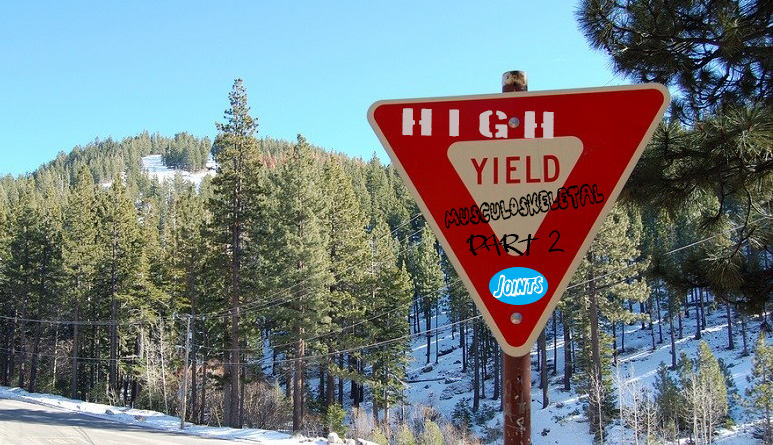Now, That’s What I Call High-Yield: Musculoskeletal, Part 2 – Joints
- by
- May 07, 2019
- Reviewed by: Amy Rontal, MD

As we continue through the musculoskeletal system for Step 1 prep, we ask the question that leads off every section of study – what is high-yield from this topic? How can I trim the excess and get the most value out of my musculoskeletal Step 1 studying? What topics deserve the most attention to net the most number of correct answers on Test Day? We already covered a number topics in Part 1 of high yield study for the musculoskeletal system, and part 2 hinges on pathologies of the joints. We will keep it brief and most high-yield.
Back Pain & Radiculopathy (7) – That pins-and-needles sensation that shoots down patients’ legs is a public health scourge. There’s a huge overlap between radiculopathy and back pain. The same holds true for neck pain and upper extremity radiculopathy. Patients suffering from radiculopathy will have a sensory and/or motor deficit in a particular dermatome. This is caused from damage to a nerve, whether generated from getting compressed by a intervertebral disc, a bone spur, a tumor, or a stenotic foramen through which they travel. Compression or damage to the nerve can often be relieved by addressing the underlying cause. Local inflammation from an injured disc might respond to a steroid injection. Surgery can open up narrowed spaces and allow a less obstructed passage for the nerve to travel. The most common spaces to experience this in the lower extremity are from L4-5 and L5-S1 disc spaces, as they are the ones with the greatest range of motion.
When it comes to back pain, your first job is to make sure this is run-of-the-mill “my back hurts” back pain, and not a more serious primary condition causing it. Dangerous not-to-be-missed pathologies include hematomas, spinal cord compression, tumors, fractures, and abscesses. Any symptoms indicative of one of these pathologies (e.g., fever, advanced age, IV drug use, midline point tenderness) should heighten your awareness to more serious underlying conditions.
After said conditions are ruled out, start with conservative measures first – frequent mobilization (not bed rest), NSAIDs and acetaminophen, ice, heat, physical therapy. We don’t need imaging for uncomplicated musculoskeletal back pain. If the patient fails the low hanging fruit of treatment, then consider moving onto an MRI.
Osteoarthritis and Rheumatoid Arthritis (8) – Ask your parents and grandparents…osteoarthritis is something that seemingly everyone faces at some point in life, usually in the later decades. It results from the wearing down of cartilage and resultant inflammation from bone-on-bone friction. Pain comes after overuse, and “illness” is limited to the joint only (local tenderness/pain without systemic symptoms). Relief comes from NSAIDs, acetaminophen, and occasionally joint injections of steroid.
Rheumatoid arthritis is an entirely different pathology that also happens to affect the joints. Breaking down the word, we see the suffix “-oid“, meaning “-like, or similar to.” Rheum comes from rheumatic fever, as rheumatoid arthritis can present like rheumatic fever, bringing on systemic autoimmune symptoms and joint pain. Immune complexes deposit in joints, causing an increase in inflammatory mediators (cytokines!), and eroding cartilage. Joint pain is usually worst in the morning when joints are stiff, and gets better with use. Patients suffer from systemic symptoms like fever, fatigue, and anemia of chronic disease. With disease progression, joints can become deformed. Treatment is more involved than standard analgesics. This autoimmune disease can respond to steroids, methotrexate, and TNF-É‘ inhibitors like etanercept.
Gout and CPDD (7) – Gout is another cause of joint pain that results from the deposition of urate crystals inside of joints. It’s a monoarthritis, usually only seen in one joint at a time. Uric acid often builds up secondary to renal failure, but can also be caused by medications like thiazides (remember the hyperGLUC that they cause…hyperglycemia, hyperlipidemia, hyperuricemia, and hypercalcemia). The most common site is the metatarsophalangeal joint of the big toe. For acute attacks, fight the inflammation with NSAIDs, steroids, and colchicine. The drugs allopurinol and febuxostat are used for prophylaxis. Gout crystals can be aspirated from joints, and are needle-shaped with negative birefringence.
Calcium pyrophosphate deposition disease (CPDD), or pseudogout as it was formerly known, is another crystal deposition disease. It affects proximal joints, most commonly the knee, and involves calcium pyrophosphate crystals in the joint spaces. These crystals are rhomboid shaped and positively birefringent. Acute treatment is the same as gout…anti-inflammatory.
Septic arthritis (8.5) – Septic arthritis makes the high yield list not because it’s exceedingly common, but because it cannot afford to be missed, and will almost certainly be on your test. This disease is marked by a very infected joint. The affected joint will be hot, red, and swollen, and because of the severity of the infection, systemic signs of SIRS or sepsis can be present…these patients are sick. Aspiration of the joint will show a very high WBC titer and bacteria on gram stain. Treat with IV antibiotics, as soon as possible.
A parting piece of wisdom – when faced with the challenge of diagnosing a joint pathology, there is no substitute for aspirating the joint, and seeing what comes out. Tons of WBC? Septic arthritis. Crystals? Look at them under the polarized light and examine birefringent to determine the disease. No abnormal findings? Likely osteoarthritis. As in any diagnostic study, no single piece of information is enough…let history and physical be your guide.









